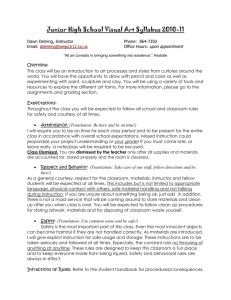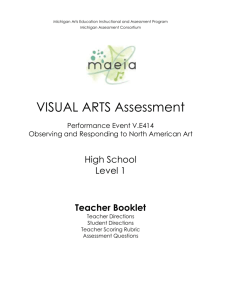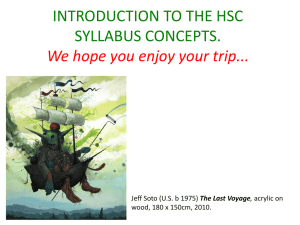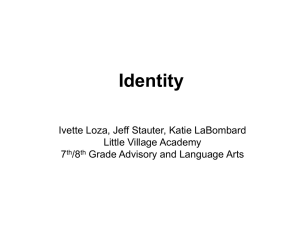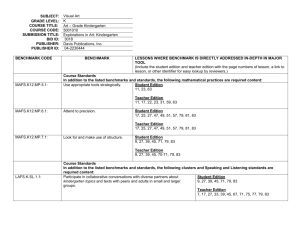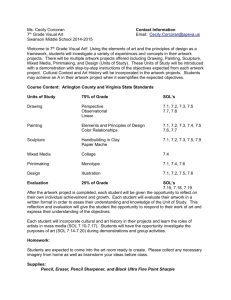Sample unit of work: Social commentary
advertisement
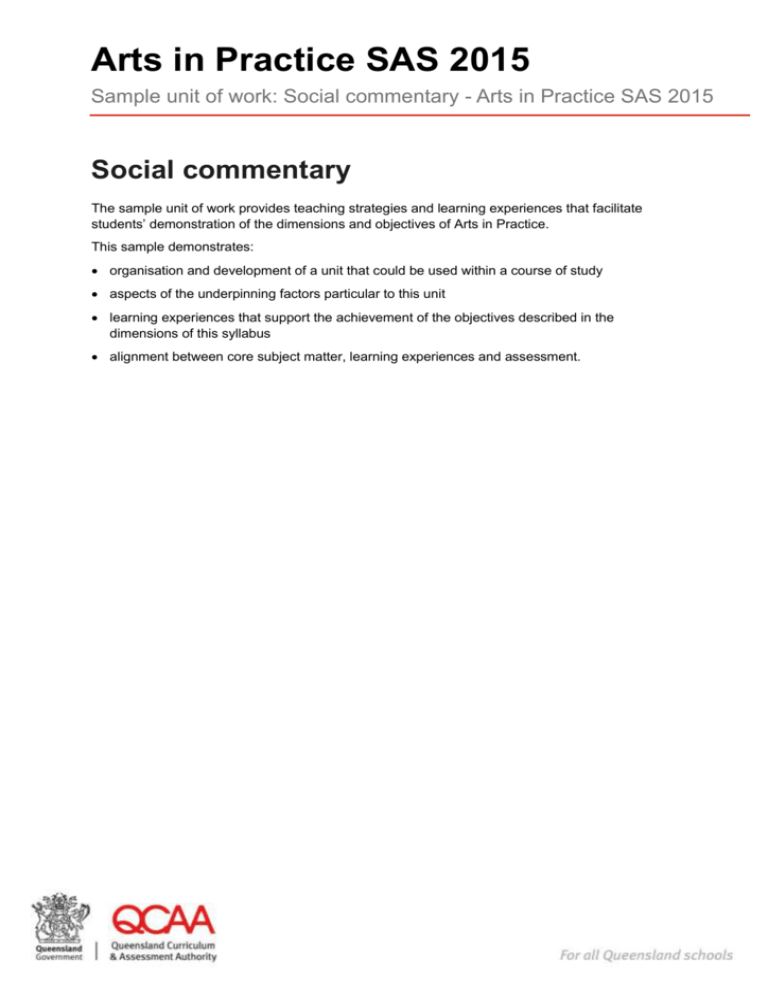
Arts in Practice SAS 2015 Sample unit of work: Social commentary - Arts in Practice SAS 2015 Social commentary The sample unit of work provides teaching strategies and learning experiences that facilitate students’ demonstration of the dimensions and objectives of Arts in Practice. This sample demonstrates: organisation and development of a unit that could be used within a course of study aspects of the underpinning factors particular to this unit learning experiences that support the achievement of the objectives described in the dimensions of this syllabus alignment between core subject matter, learning experiences and assessment. Overview Unit overview Title of unit: Social commentary Unit description (focus): The purpose of this unit is to explore ways in which the arts are used to make social comment. Students produce an artwork that makes comment on an aspect of society. Through a project, students create an artwork which can be used for advocacy purposes within a community. Time allocation: Unit 3, Semester 3, 55 hours Identified curriculum from the syllabus Dimensions and objectives Knowing and understanding identify and explain concepts and ideas related to arts literacies and arts processes interpret information about arts literacies and arts processes demonstrate arts literacies and processes in arts making Applying and analysing organise and apply arts literacies and arts processes to achieve goals analyse artworks and arts processes use language conventions and features to convey information and meaning about arts forms, works and processes Creating and evaluating generate arts ideas and plan arts processes implement arts processes to create communications and realise artworks evaluate artworks and processes Electives Dance Drama Media arts Music Visual arts Core Core topic 1: Arts literacies Concepts and ideas Knowledge, understanding and skills Arts communication The ability to communicate in and about the arts facilitates the interpretation and presentation of information, the conveying of meaning, and the sharing of ideas about art forms, artworks and processes (C1.1). arts-specific terminology communication skills: active listening conflict resolution and negotiation skills providing instructions reflection and review clarity of communication and expression Arts in Practice SAS 2015 Sample unit of work: Social commentary - Arts in Practice SAS 2015 — Social commentary Queensland Curriculum & Assessment Authority October 2015 Page 2 of 7 Arts principles Arts principles are the understandings that serve as a foundation for learning and engagement in the Arts (C1.2). Aesthetic appreciation A knowledge and understanding of arts principles is essential for developing aesthetic appreciation or artistic awareness (i.e. understanding the meaning) of an artistic experience (C1.3). description, analysis and interpretation of artworks, including genres forms and/or styles elements and/or mediums conventions structures functions and/or purposes comparative skills evaluation of aesthetic choices reflective skills provision of critiques, including feedback on artworks and arts processes Core topic 2: Arts processes Concepts and ideas Knowledge, understanding and skills Integration of art forms Artistic expression is often strengthened through integrating art forms (C2.1). Arts technologies, techniques and skills Art forms have specific technologies, techniques and skills (C2.2). technologies specific to the chosen art forms techniques and skills specific to the chosen art forms techniques and skills common to multiple disciplines Artwork realisation Each artwork has the capacity to convey intended meaning to an audience (C2.3). production skills presentation skills curatorial skills skills in the integration of art forms conceptualisation and planning of artworks refinement and modification of arts ideas and art-making processes decision-making and problem-solving skills organisation of resources Assessment Assessment 1: Produce an artwork that makes comment on an aspect of society Assessment technique Artwork Dimensions assessed Knowing and understanding Analysing and applying Creating and evaluating Description of instrument Students create an artwork that makes comment on an aspect of society and integrates two or more art forms. Assessment conditions Schools provide students with some continuous class time to develop the response. Schools should provide students with guidance so that it is possible to achieve the artworks with available resources, and within the allocated time. Arts in Practice SAS 2015 Sample unit of work: Social commentary - Arts in Practice SAS 2015 — Social commentary Queensland Curriculum & Assessment Authority October 2015 Page 3 of 7 Assessment 2: Create an artwork that can be used for advocacy purposes within a community1 Assessment technique Project Dimensions assessed Knowing and understanding Analysing and applying Creating and evaluating Description of instrument Students create an artwork that can be used for advocacy purposes within a community, and that integrates at least two art forms. Students deliver a multimodal presentation in which they analyse, discuss and evaluate their artwork and art-making processes in relation to its advocacy message. There are two assessable components. Artwork component: creation of an artwork Multimodal component: analysis, discussion and evaluation of student’s artwork and art-making processes in relation to its advocacy message. Assessment conditions Artwork component Schools provide students with some continuous class time to develop the artwork. Schools provide students with guidance so that artworks are possible to achieve with available resources and within the allocated time. Multimodal component — non-presentation or presentation 8 A4 pages max (or equivalent) 3–6 minutes Teaching and learning sequence Teaching strategies and learning experiences2 Introduction to the unit and assessment tasks Teacher: explains the learning goals for the unit introduces the concept of the arts as vehicles for making social comment (C1.2) clearly outlines the assessment tasks explores and analyses a variety of existing art works that make social comment (C1.2) provides opportunity for discussion of social issues models the use of various media provides workshop opportunities for students to experiment with various media provides opportunities for students to workshop and share their ideas. Students: engage with unit content including: terminology arts principles and processes functions and/or purposes of the arts as vehicles for making social comment analysis and interpretation of artworks evaluation of aesthetic choices (C1.1, C1.2, C1.3) 1 See www.qcaa.qld.edu.au/36668-assessment.html for assessment resources. 2 Note: highlighted key verbs relate to the dimensions Arts in Practice SAS 2015 Sample unit of work: Social commentary - Arts in Practice SAS 2015 — Social commentary Queensland Curriculum & Assessment Authority October 2015 Page 4 of 7 investigate a variety of historical artworks that make social comment, using a range of art forms and contexts, e.g. Goya, Picasso, The Beggar’s Opera by John Gay, Mother Courage and her Children by Bertolt Brecht (C1.1, C1.2, C1.3) explore a variety of contemporary artworks that make social comment, using a range of art forms and contexts, e.g. Bansky, Bangarra Theatre Company, Courtney Barnett, Real TV theatre company, U2, a current multimedia campaign (C1.1, C1.2, C1.3) identify and explain the conventions of the genres and styles used and how the integration of art forms strengthens artistic expression (C1.1, C1.2, C1.3, C2.1) identify and explain how particular art forms have specific processes, skills, technologies and techniques (C1.1, C1.2, C1.3, C2.2) interpret and analyse the artwork to show understanding of the social comment expressed (C1.1, C1.2, C1.3, C2.1) discuss and evaluate the aesthetic choices made in the artworks, using arts terminology (C1.1, C1.2, C1.3, C2.1) demonstrate arts literacies and processes through participation in workshop activities that explore and experiment with genres/forms/styles, elements, mediums, conventions and structures from a variety of art forms (C1.1, C1.2, C1.3, C2.1, C2.2) workshop and share ideas with peers (C1.1). Assessment 1: Artwork — Produce an artwork that makes comment on an aspect of society and integrates two or more art forms. Teacher: gives feedback to students on arts ideas, processes and artworks from workshop activities provides a range of stimulus materials and models the process of making social comment provides a teacher-created exemplar of an artwork that makes social comment provides adequate time for students to develop and refine arts literacies, processes and skills explains the processes of reflection and evaluation demonstrates and explains models of critiquing artwork models appropriate ways of providing constructive feedback to others discusses the importance and benefits of collaborative working relationships. Students: explore a range of stimulus materials to identify a possible focus for social comment, e.g. observations, newspapers, social media (C1.2, C1.3) select two or more art forms to express a chosen social comment (C2.1) experiment with media and generate arts ideas (C2.1, C2.2) plan arts processes (C2.1) practise and refine arts literacies, processes and skills (C1.1, C1.2, C1.3, C2.1, C2.2, C2.3) organise, apply and implement arts literacies and arts processes to realise an artwork that integrates at least two art forms to communicate a social comment (C1.1, C1.2, C1.3, C2.1, C2.2, C2.3) use verbal and/or symbolic language conventions and features to convey information and meaning through and about art forms and arts processes (C1.1, C1.2, C1.3) share artworks with peers to develop aesthetic appreciation or artistic awareness of an artistic experience (C1.3) examine models of critiquing artwork (C1.1, C1.2, C1.3, C2.3) evaluate each other’s artworks and provide feedback (C1.1, C1.2, C1.3) reflect on own art-making processes and the choices made (C1.1, C1.2, C1.3). Arts in Practice SAS 2015 Sample unit of work: Social commentary - Arts in Practice SAS 2015 — Social commentary Queensland Curriculum & Assessment Authority October 2015 Page 5 of 7 Assessment 2: Project — Create an artwork that can be used for advocacy purposes within a community. Teacher: discusses the concept of advocacy in the arts, using relevant examples (C1.1, C1.2, C1.3) discusses concepts of community and community identity, values and needs (C1.1 C1.2, C1.3) clarifies the requirements for the artwork models how advocacy can be used within a community context presents the concept of aesthetic appreciation through the analysis of an artwork (C1.3) revisits the processes of reflection and evaluation provides stimulus materials for discussion and experimentation demonstrates processes for experimenting with media links documenting process with multimodal3 presentation component of the project provides adequate time for students to generate arts ideas, plan and organise and implement arts literacies and processes gives feedback to students on artworks. Students: explore advocacy as a purpose for developing artworks (C1.1, C1.2, C1.3) explore concepts of community and community identity, values and needs (C1.1, C1.2, C1.3) select a community context that will benefit from advocacy through an artwork commence documentation of arts-making processes in a folio (C1.1, C2.1, C2.3) select two or more art forms for an advocacy project for a chosen community generate arts ideas and plan arts processes, including gathering information and resources (C2.1, C2.2, C2.3) organise and apply arts literacies and arts processes to achieve goals in the development of an artwork that can be used for advocacy purposes within a community, and that integrates at least two art forms (C1.1, C1.2, C1.3, C2.1, C2.2, C2.3) implement arts processes to realise an artwork that uses verbal and/or symbolic language conventions and features to convey information and meaning through and about art forms and arts processes (C1.1, C2.1, C2.2, C2.3) discuss artworks with peers to develop aesthetic appreciation or aesthetic awareness of an artistic experience (C1.1, C1.3) evaluate art-making processes and refine and modify as needed (C2.1, C2.2) present artworks to the selected community (C2.3). Assessment 2: Project — delivering a multimodal presentation Teacher: revisits documenting processes and the preparation of the multimodal presentation explains appropriate use of language conventions and features to communicate arts ideas and information. Students: prepare and deliver a multimodal presentation in which the artworks and art-making processes are analysed, discussed and evaluated in relation to their intended advocacy messages (C1.1, C1.2, C1.3, C2.1, C2.2, C2.3). 3 Multimodal components can be presentations or non-presentations. Examples of presentations include delivery of a slide show, a short video clip, a biographical narrative or webinar. An example of a non-presentation is a webpage with embedded media (graphics, images, audio or video). Arts in Practice SAS 2015 Sample unit of work: Social commentary - Arts in Practice SAS 2015 — Social commentary Queensland Curriculum & Assessment Authority October 2015 Page 6 of 7 Resources Selection of historical artworks that illustrate social comment, e.g. works by Goya and Picasso, The Beggar’s Opera by John Gay, Mother Courage and her Children by Bertolt Brecht, Threepenny Opera by Brecht/Weill, Peter Grimes by Benjamin Britten, songs by Bob Dylan, Joan Baez, Pete Seeger, John Lennon, Paul Kelly, Kate Miller-Heidke, Midnight Oil Selection of contemporary artworks that illustrate social comment, e.g. Bansky, Bangarra Theatre Company, Courtney Barnett, Real TV theatre company, U2, a current multimedia campaign Variety of media and technology, e.g. video recorders, music software, recordings, YouTube clips, newspapers cutting, contemporary music, magazine articles, graffiti artworks Art space for the exhibition of artworks Arts in Practice SAS 2015 Sample unit of work: Social commentary - Arts in Practice SAS 2015 — Social commentary Queensland Curriculum & Assessment Authority October 2015 Page 7 of 7


